ICS Learn: Assessment for Delivering Learning & Development Activities
VerifiedAdded on 2022/10/12
|12
|3703
|231
Report
AI Summary
This report analyzes the key components of delivering effective Learning and Development (L&D) activities. It begins by emphasizing the importance of preparing a conducive training environment, including conducting thorough training needs analysis, aligning learning outcomes with business objectives, and planning appropriate training methods. The report then explores various training techniques and methods for engaging learners, such as active listening, instructor-led training, role-playing, and collaborative virtual classrooms. It also covers the use of training resources, monitoring learner progress, and making adjustments to ensure inclusivity. Furthermore, the report discusses methods for closing an L&D activity, including ball learning toss and action plans. The report also includes a reflective statement on the author's abilities and willingness to deliver the activity, highlighting essential trainer attributes like subject knowledge, communication skills, and the ability to build trust. This analysis is crucial for anyone involved in designing, delivering, and evaluating L&D programs, ensuring that training is effective and aligned with organizational goals.
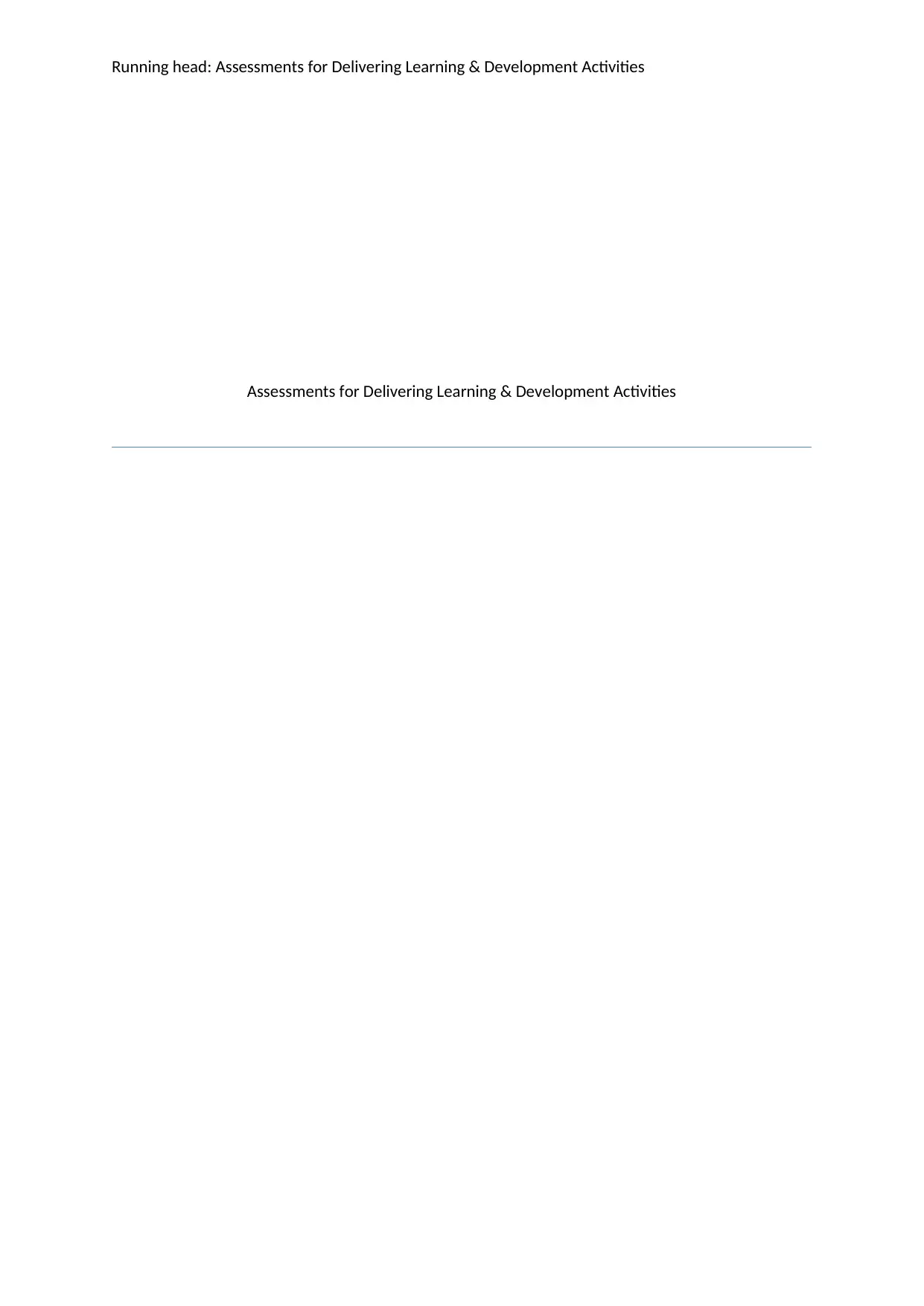
Running head: Assessments for Delivering Learning & Development Activities
Assessments for Delivering Learning & Development Activities
Assessments for Delivering Learning & Development Activities
Paraphrase This Document
Need a fresh take? Get an instant paraphrase of this document with our AI Paraphraser
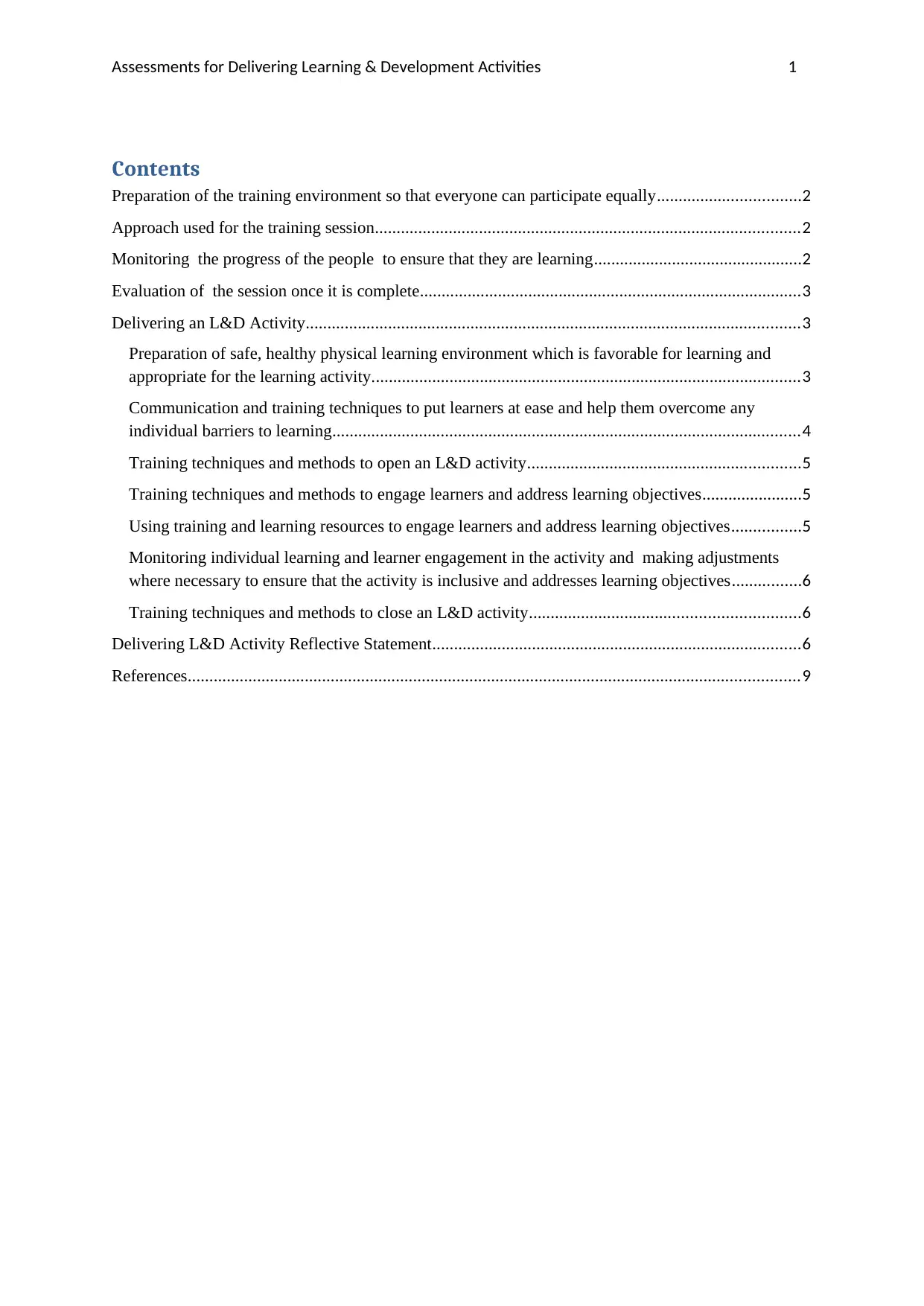
Assessments for Delivering Learning & Development Activities 1
Contents
Preparation of the training environment so that everyone can participate equally.................................2
Approach used for the training session..................................................................................................2
Monitoring the progress of the people to ensure that they are learning................................................2
Evaluation of the session once it is complete........................................................................................3
Delivering an L&D Activity..................................................................................................................3
Preparation of safe, healthy physical learning environment which is favorable for learning and
appropriate for the learning activity...................................................................................................3
Communication and training techniques to put learners at ease and help them overcome any
individual barriers to learning............................................................................................................4
Training techniques and methods to open an L&D activity...............................................................5
Training techniques and methods to engage learners and address learning objectives.......................5
Using training and learning resources to engage learners and address learning objectives................5
Monitoring individual learning and learner engagement in the activity and making adjustments
where necessary to ensure that the activity is inclusive and addresses learning objectives................6
Training techniques and methods to close an L&D activity..............................................................6
Delivering L&D Activity Reflective Statement.....................................................................................6
References.............................................................................................................................................9
Contents
Preparation of the training environment so that everyone can participate equally.................................2
Approach used for the training session..................................................................................................2
Monitoring the progress of the people to ensure that they are learning................................................2
Evaluation of the session once it is complete........................................................................................3
Delivering an L&D Activity..................................................................................................................3
Preparation of safe, healthy physical learning environment which is favorable for learning and
appropriate for the learning activity...................................................................................................3
Communication and training techniques to put learners at ease and help them overcome any
individual barriers to learning............................................................................................................4
Training techniques and methods to open an L&D activity...............................................................5
Training techniques and methods to engage learners and address learning objectives.......................5
Using training and learning resources to engage learners and address learning objectives................5
Monitoring individual learning and learner engagement in the activity and making adjustments
where necessary to ensure that the activity is inclusive and addresses learning objectives................6
Training techniques and methods to close an L&D activity..............................................................6
Delivering L&D Activity Reflective Statement.....................................................................................6
References.............................................................................................................................................9
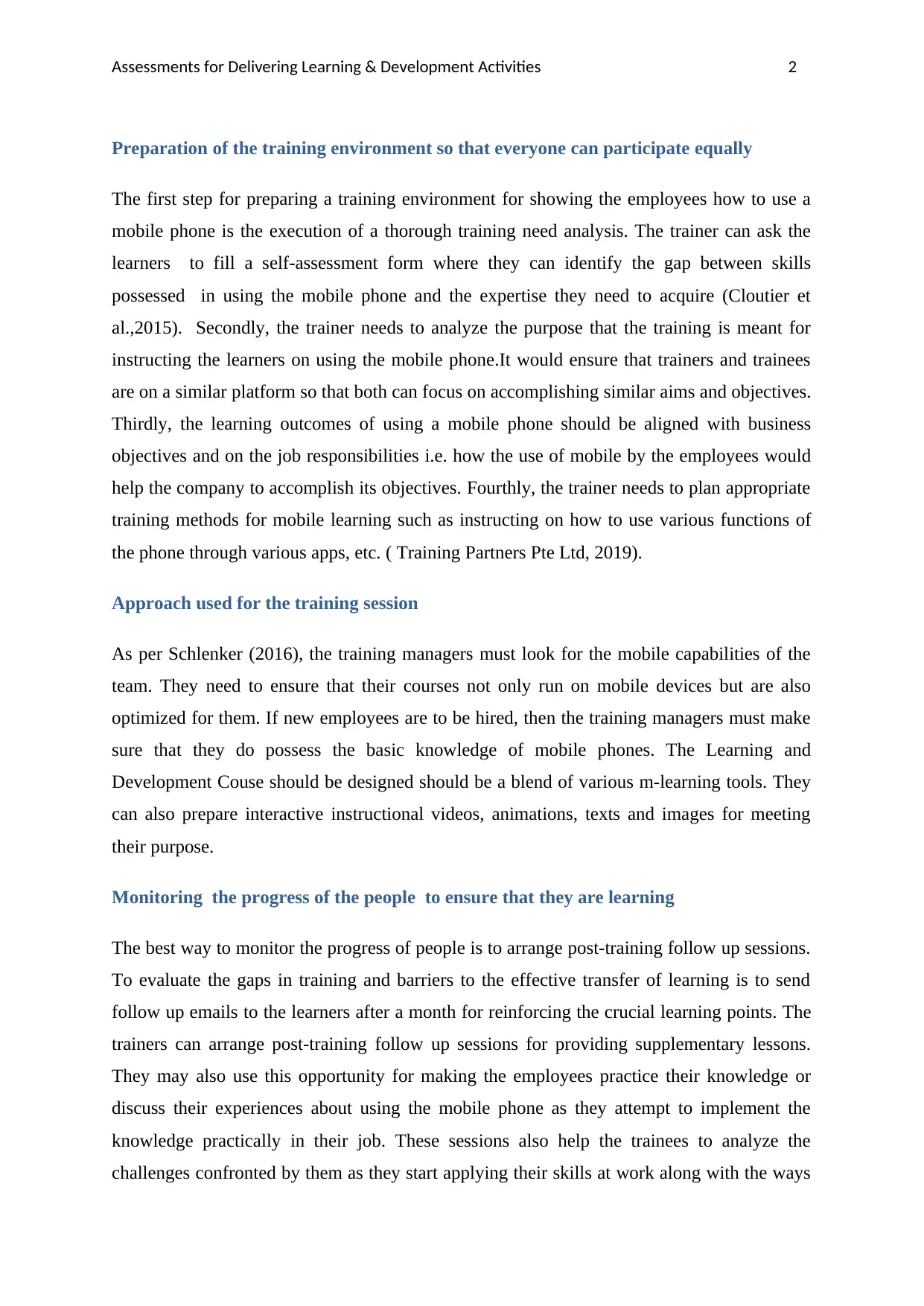
Assessments for Delivering Learning & Development Activities 2
Preparation of the training environment so that everyone can participate equally
The first step for preparing a training environment for showing the employees how to use a
mobile phone is the execution of a thorough training need analysis. The trainer can ask the
learners to fill a self-assessment form where they can identify the gap between skills
possessed in using the mobile phone and the expertise they need to acquire (Cloutier et
al.,2015). Secondly, the trainer needs to analyze the purpose that the training is meant for
instructing the learners on using the mobile phone.It would ensure that trainers and trainees
are on a similar platform so that both can focus on accomplishing similar aims and objectives.
Thirdly, the learning outcomes of using a mobile phone should be aligned with business
objectives and on the job responsibilities i.e. how the use of mobile by the employees would
help the company to accomplish its objectives. Fourthly, the trainer needs to plan appropriate
training methods for mobile learning such as instructing on how to use various functions of
the phone through various apps, etc. ( Training Partners Pte Ltd, 2019).
Approach used for the training session
As per Schlenker (2016), the training managers must look for the mobile capabilities of the
team. They need to ensure that their courses not only run on mobile devices but are also
optimized for them. If new employees are to be hired, then the training managers must make
sure that they do possess the basic knowledge of mobile phones. The Learning and
Development Couse should be designed should be a blend of various m-learning tools. They
can also prepare interactive instructional videos, animations, texts and images for meeting
their purpose.
Monitoring the progress of the people to ensure that they are learning
The best way to monitor the progress of people is to arrange post-training follow up sessions.
To evaluate the gaps in training and barriers to the effective transfer of learning is to send
follow up emails to the learners after a month for reinforcing the crucial learning points. The
trainers can arrange post-training follow up sessions for providing supplementary lessons.
They may also use this opportunity for making the employees practice their knowledge or
discuss their experiences about using the mobile phone as they attempt to implement the
knowledge practically in their job. These sessions also help the trainees to analyze the
challenges confronted by them as they start applying their skills at work along with the ways
Preparation of the training environment so that everyone can participate equally
The first step for preparing a training environment for showing the employees how to use a
mobile phone is the execution of a thorough training need analysis. The trainer can ask the
learners to fill a self-assessment form where they can identify the gap between skills
possessed in using the mobile phone and the expertise they need to acquire (Cloutier et
al.,2015). Secondly, the trainer needs to analyze the purpose that the training is meant for
instructing the learners on using the mobile phone.It would ensure that trainers and trainees
are on a similar platform so that both can focus on accomplishing similar aims and objectives.
Thirdly, the learning outcomes of using a mobile phone should be aligned with business
objectives and on the job responsibilities i.e. how the use of mobile by the employees would
help the company to accomplish its objectives. Fourthly, the trainer needs to plan appropriate
training methods for mobile learning such as instructing on how to use various functions of
the phone through various apps, etc. ( Training Partners Pte Ltd, 2019).
Approach used for the training session
As per Schlenker (2016), the training managers must look for the mobile capabilities of the
team. They need to ensure that their courses not only run on mobile devices but are also
optimized for them. If new employees are to be hired, then the training managers must make
sure that they do possess the basic knowledge of mobile phones. The Learning and
Development Couse should be designed should be a blend of various m-learning tools. They
can also prepare interactive instructional videos, animations, texts and images for meeting
their purpose.
Monitoring the progress of the people to ensure that they are learning
The best way to monitor the progress of people is to arrange post-training follow up sessions.
To evaluate the gaps in training and barriers to the effective transfer of learning is to send
follow up emails to the learners after a month for reinforcing the crucial learning points. The
trainers can arrange post-training follow up sessions for providing supplementary lessons.
They may also use this opportunity for making the employees practice their knowledge or
discuss their experiences about using the mobile phone as they attempt to implement the
knowledge practically in their job. These sessions also help the trainees to analyze the
challenges confronted by them as they start applying their skills at work along with the ways
⊘ This is a preview!⊘
Do you want full access?
Subscribe today to unlock all pages.

Trusted by 1+ million students worldwide
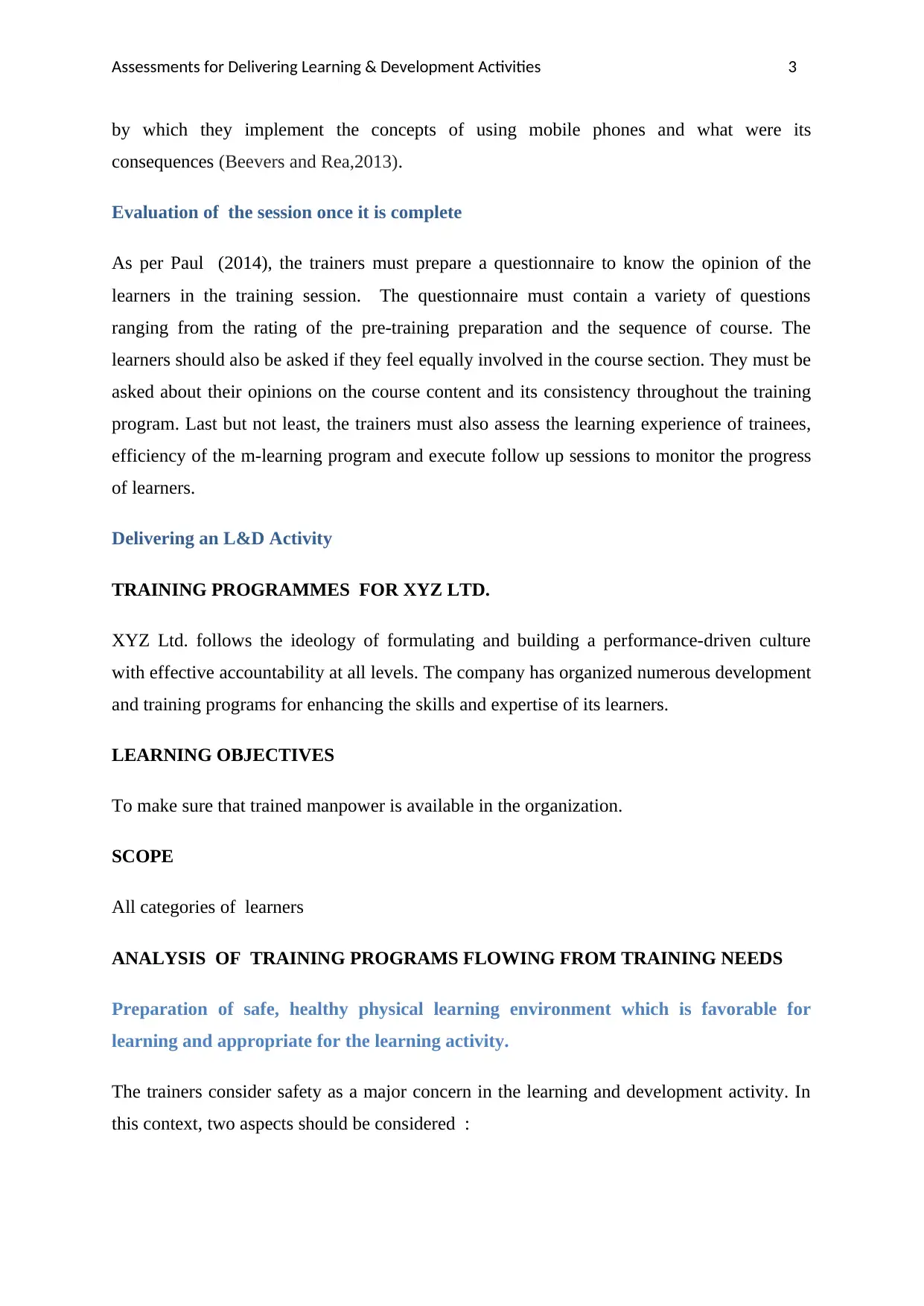
Assessments for Delivering Learning & Development Activities 3
by which they implement the concepts of using mobile phones and what were its
consequences (Beevers and Rea,2013).
Evaluation of the session once it is complete
As per Paul (2014), the trainers must prepare a questionnaire to know the opinion of the
learners in the training session. The questionnaire must contain a variety of questions
ranging from the rating of the pre-training preparation and the sequence of course. The
learners should also be asked if they feel equally involved in the course section. They must be
asked about their opinions on the course content and its consistency throughout the training
program. Last but not least, the trainers must also assess the learning experience of trainees,
efficiency of the m-learning program and execute follow up sessions to monitor the progress
of learners.
Delivering an L&D Activity
TRAINING PROGRAMMES FOR XYZ LTD.
XYZ Ltd. follows the ideology of formulating and building a performance-driven culture
with effective accountability at all levels. The company has organized numerous development
and training programs for enhancing the skills and expertise of its learners.
LEARNING OBJECTIVES
To make sure that trained manpower is available in the organization.
SCOPE
All categories of learners
ANALYSIS OF TRAINING PROGRAMS FLOWING FROM TRAINING NEEDS
Preparation of safe, healthy physical learning environment which is favorable for
learning and appropriate for the learning activity.
The trainers consider safety as a major concern in the learning and development activity. In
this context, two aspects should be considered :
by which they implement the concepts of using mobile phones and what were its
consequences (Beevers and Rea,2013).
Evaluation of the session once it is complete
As per Paul (2014), the trainers must prepare a questionnaire to know the opinion of the
learners in the training session. The questionnaire must contain a variety of questions
ranging from the rating of the pre-training preparation and the sequence of course. The
learners should also be asked if they feel equally involved in the course section. They must be
asked about their opinions on the course content and its consistency throughout the training
program. Last but not least, the trainers must also assess the learning experience of trainees,
efficiency of the m-learning program and execute follow up sessions to monitor the progress
of learners.
Delivering an L&D Activity
TRAINING PROGRAMMES FOR XYZ LTD.
XYZ Ltd. follows the ideology of formulating and building a performance-driven culture
with effective accountability at all levels. The company has organized numerous development
and training programs for enhancing the skills and expertise of its learners.
LEARNING OBJECTIVES
To make sure that trained manpower is available in the organization.
SCOPE
All categories of learners
ANALYSIS OF TRAINING PROGRAMS FLOWING FROM TRAINING NEEDS
Preparation of safe, healthy physical learning environment which is favorable for
learning and appropriate for the learning activity.
The trainers consider safety as a major concern in the learning and development activity. In
this context, two aspects should be considered :
Paraphrase This Document
Need a fresh take? Get an instant paraphrase of this document with our AI Paraphraser
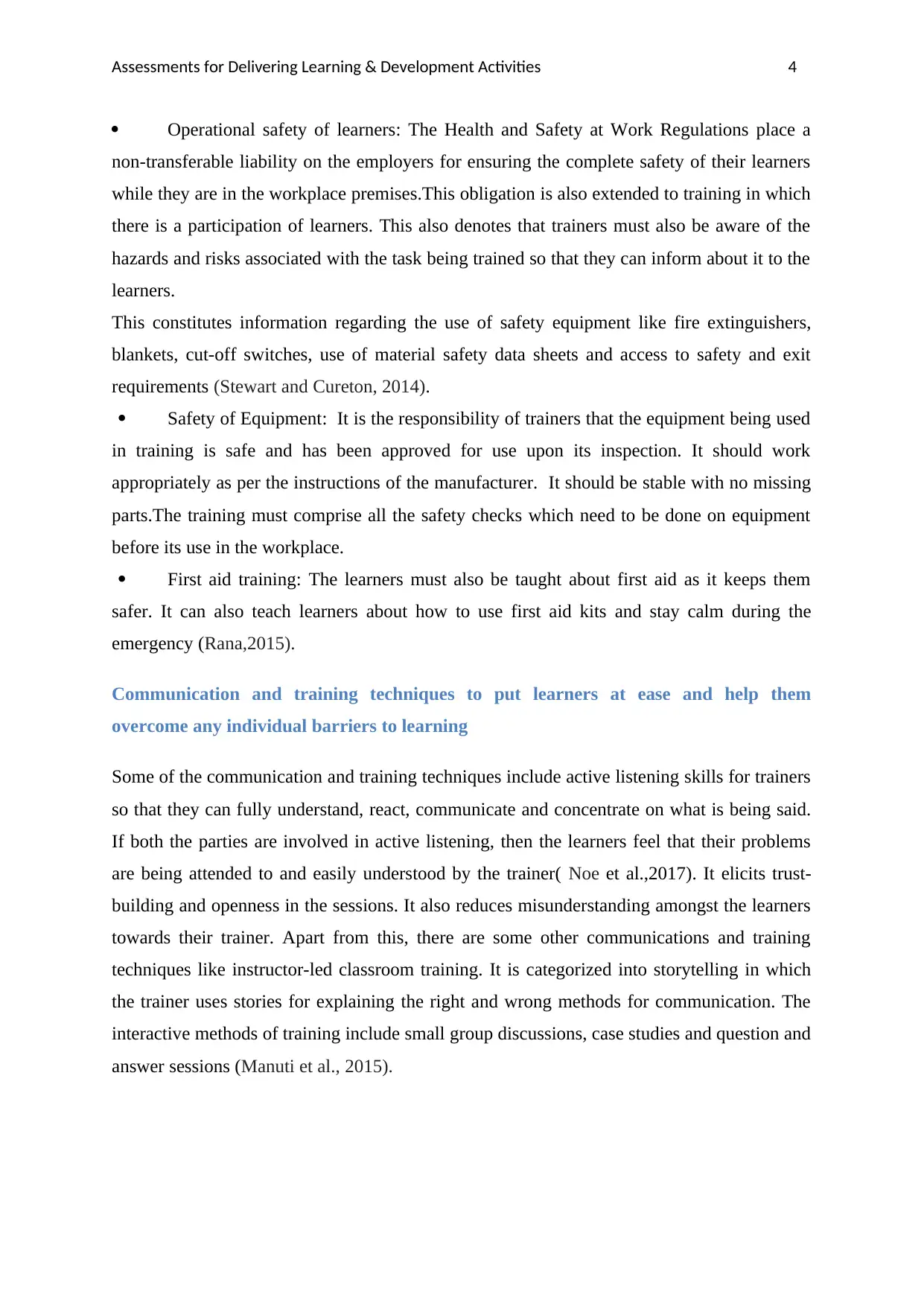
Assessments for Delivering Learning & Development Activities 4
Operational safety of learners: The Health and Safety at Work Regulations place a
non-transferable liability on the employers for ensuring the complete safety of their learners
while they are in the workplace premises.This obligation is also extended to training in which
there is a participation of learners. This also denotes that trainers must also be aware of the
hazards and risks associated with the task being trained so that they can inform about it to the
learners.
This constitutes information regarding the use of safety equipment like fire extinguishers,
blankets, cut-off switches, use of material safety data sheets and access to safety and exit
requirements (Stewart and Cureton, 2014).
Safety of Equipment: It is the responsibility of trainers that the equipment being used
in training is safe and has been approved for use upon its inspection. It should work
appropriately as per the instructions of the manufacturer. It should be stable with no missing
parts.The training must comprise all the safety checks which need to be done on equipment
before its use in the workplace.
First aid training: The learners must also be taught about first aid as it keeps them
safer. It can also teach learners about how to use first aid kits and stay calm during the
emergency (Rana,2015).
Communication and training techniques to put learners at ease and help them
overcome any individual barriers to learning
Some of the communication and training techniques include active listening skills for trainers
so that they can fully understand, react, communicate and concentrate on what is being said.
If both the parties are involved in active listening, then the learners feel that their problems
are being attended to and easily understood by the trainer( Noe et al.,2017). It elicits trust-
building and openness in the sessions. It also reduces misunderstanding amongst the learners
towards their trainer. Apart from this, there are some other communications and training
techniques like instructor-led classroom training. It is categorized into storytelling in which
the trainer uses stories for explaining the right and wrong methods for communication. The
interactive methods of training include small group discussions, case studies and question and
answer sessions (Manuti et al., 2015).
Operational safety of learners: The Health and Safety at Work Regulations place a
non-transferable liability on the employers for ensuring the complete safety of their learners
while they are in the workplace premises.This obligation is also extended to training in which
there is a participation of learners. This also denotes that trainers must also be aware of the
hazards and risks associated with the task being trained so that they can inform about it to the
learners.
This constitutes information regarding the use of safety equipment like fire extinguishers,
blankets, cut-off switches, use of material safety data sheets and access to safety and exit
requirements (Stewart and Cureton, 2014).
Safety of Equipment: It is the responsibility of trainers that the equipment being used
in training is safe and has been approved for use upon its inspection. It should work
appropriately as per the instructions of the manufacturer. It should be stable with no missing
parts.The training must comprise all the safety checks which need to be done on equipment
before its use in the workplace.
First aid training: The learners must also be taught about first aid as it keeps them
safer. It can also teach learners about how to use first aid kits and stay calm during the
emergency (Rana,2015).
Communication and training techniques to put learners at ease and help them
overcome any individual barriers to learning
Some of the communication and training techniques include active listening skills for trainers
so that they can fully understand, react, communicate and concentrate on what is being said.
If both the parties are involved in active listening, then the learners feel that their problems
are being attended to and easily understood by the trainer( Noe et al.,2017). It elicits trust-
building and openness in the sessions. It also reduces misunderstanding amongst the learners
towards their trainer. Apart from this, there are some other communications and training
techniques like instructor-led classroom training. It is categorized into storytelling in which
the trainer uses stories for explaining the right and wrong methods for communication. The
interactive methods of training include small group discussions, case studies and question and
answer sessions (Manuti et al., 2015).
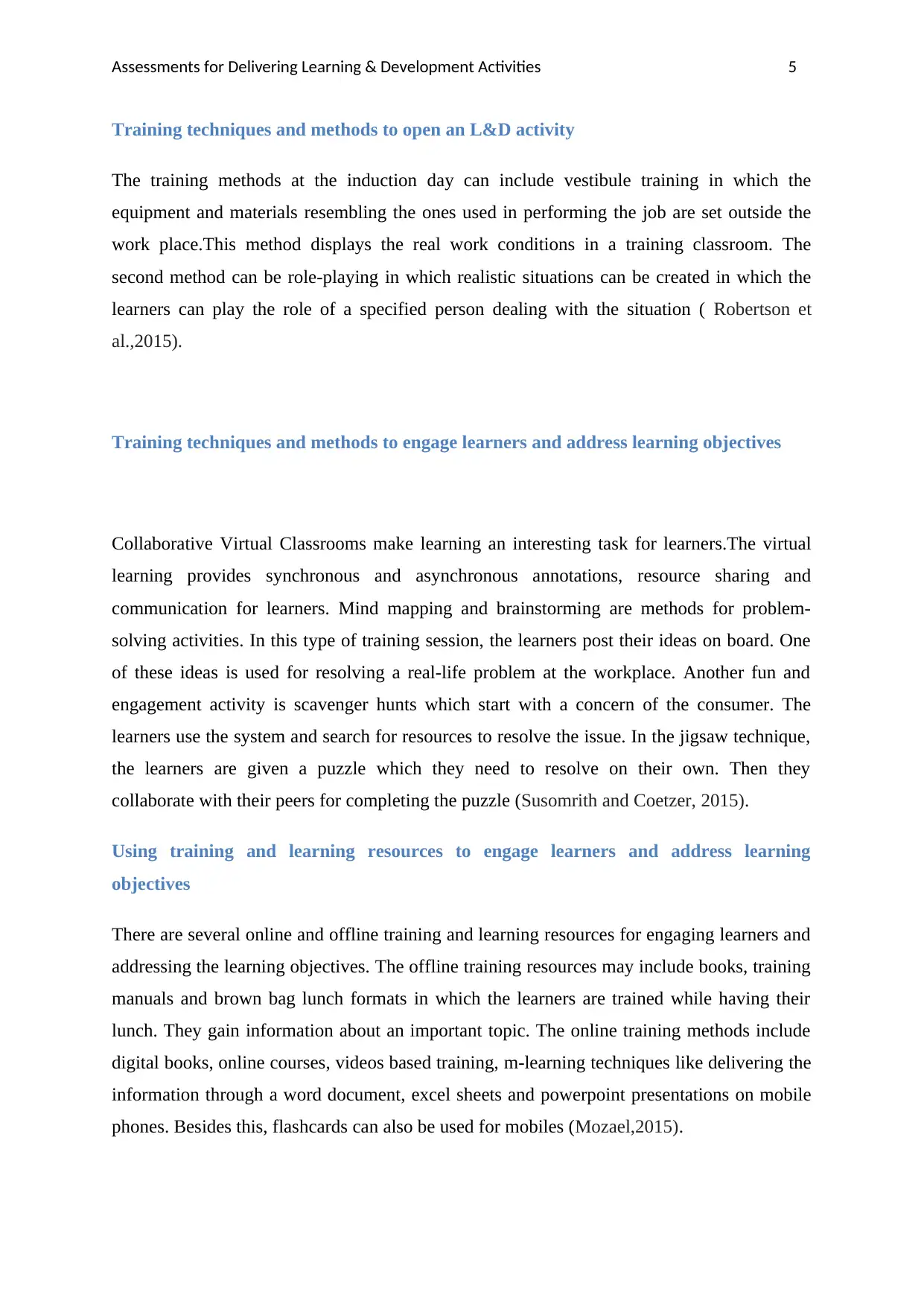
Assessments for Delivering Learning & Development Activities 5
Training techniques and methods to open an L&D activity
The training methods at the induction day can include vestibule training in which the
equipment and materials resembling the ones used in performing the job are set outside the
work place.This method displays the real work conditions in a training classroom. The
second method can be role-playing in which realistic situations can be created in which the
learners can play the role of a specified person dealing with the situation ( Robertson et
al.,2015).
Training techniques and methods to engage learners and address learning objectives
Collaborative Virtual Classrooms make learning an interesting task for learners.The virtual
learning provides synchronous and asynchronous annotations, resource sharing and
communication for learners. Mind mapping and brainstorming are methods for problem-
solving activities. In this type of training session, the learners post their ideas on board. One
of these ideas is used for resolving a real-life problem at the workplace. Another fun and
engagement activity is scavenger hunts which start with a concern of the consumer. The
learners use the system and search for resources to resolve the issue. In the jigsaw technique,
the learners are given a puzzle which they need to resolve on their own. Then they
collaborate with their peers for completing the puzzle (Susomrith and Coetzer, 2015).
Using training and learning resources to engage learners and address learning
objectives
There are several online and offline training and learning resources for engaging learners and
addressing the learning objectives. The offline training resources may include books, training
manuals and brown bag lunch formats in which the learners are trained while having their
lunch. They gain information about an important topic. The online training methods include
digital books, online courses, videos based training, m-learning techniques like delivering the
information through a word document, excel sheets and powerpoint presentations on mobile
phones. Besides this, flashcards can also be used for mobiles (Mozael,2015).
Training techniques and methods to open an L&D activity
The training methods at the induction day can include vestibule training in which the
equipment and materials resembling the ones used in performing the job are set outside the
work place.This method displays the real work conditions in a training classroom. The
second method can be role-playing in which realistic situations can be created in which the
learners can play the role of a specified person dealing with the situation ( Robertson et
al.,2015).
Training techniques and methods to engage learners and address learning objectives
Collaborative Virtual Classrooms make learning an interesting task for learners.The virtual
learning provides synchronous and asynchronous annotations, resource sharing and
communication for learners. Mind mapping and brainstorming are methods for problem-
solving activities. In this type of training session, the learners post their ideas on board. One
of these ideas is used for resolving a real-life problem at the workplace. Another fun and
engagement activity is scavenger hunts which start with a concern of the consumer. The
learners use the system and search for resources to resolve the issue. In the jigsaw technique,
the learners are given a puzzle which they need to resolve on their own. Then they
collaborate with their peers for completing the puzzle (Susomrith and Coetzer, 2015).
Using training and learning resources to engage learners and address learning
objectives
There are several online and offline training and learning resources for engaging learners and
addressing the learning objectives. The offline training resources may include books, training
manuals and brown bag lunch formats in which the learners are trained while having their
lunch. They gain information about an important topic. The online training methods include
digital books, online courses, videos based training, m-learning techniques like delivering the
information through a word document, excel sheets and powerpoint presentations on mobile
phones. Besides this, flashcards can also be used for mobiles (Mozael,2015).
⊘ This is a preview!⊘
Do you want full access?
Subscribe today to unlock all pages.

Trusted by 1+ million students worldwide
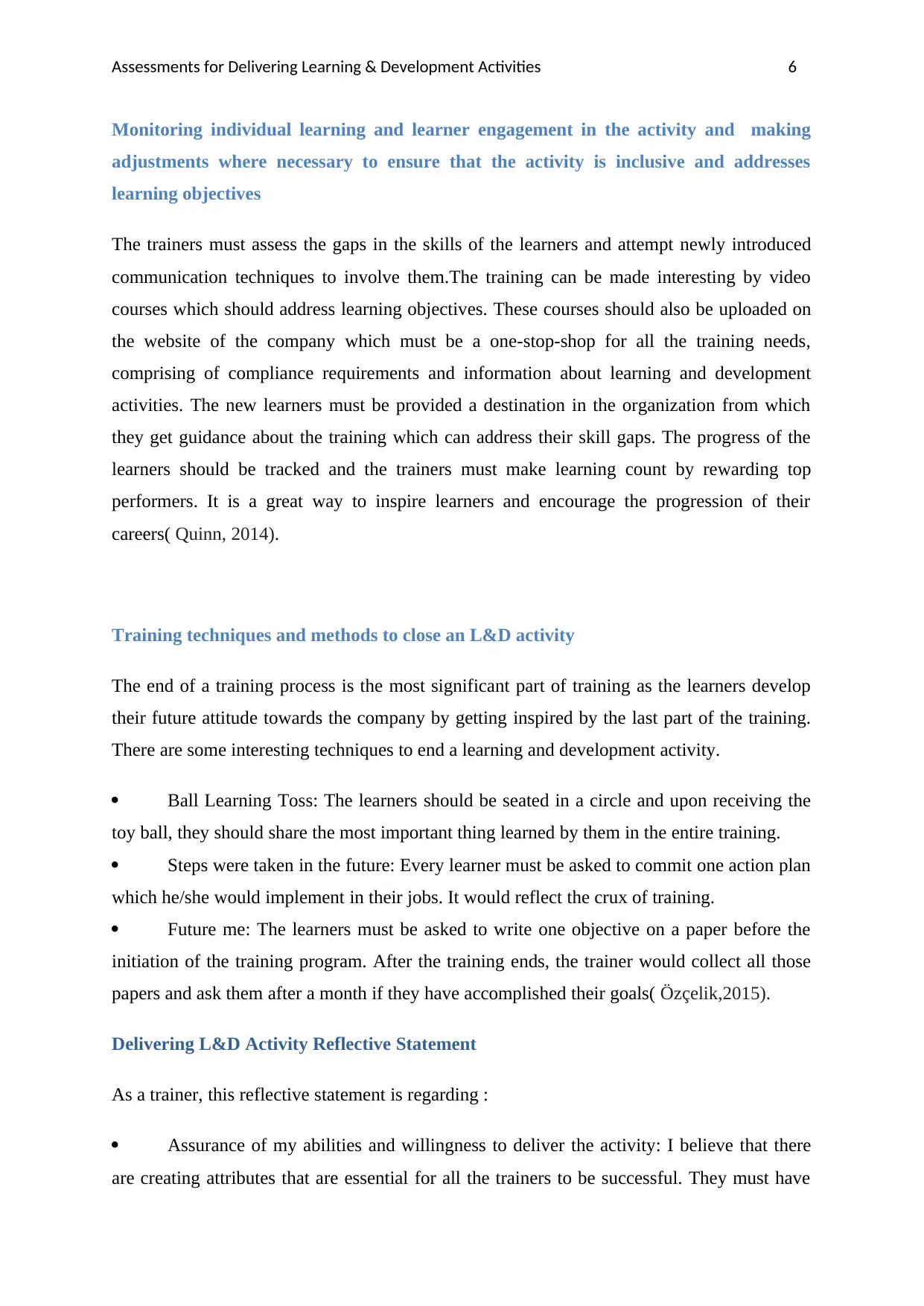
Assessments for Delivering Learning & Development Activities 6
Monitoring individual learning and learner engagement in the activity and making
adjustments where necessary to ensure that the activity is inclusive and addresses
learning objectives
The trainers must assess the gaps in the skills of the learners and attempt newly introduced
communication techniques to involve them.The training can be made interesting by video
courses which should address learning objectives. These courses should also be uploaded on
the website of the company which must be a one-stop-shop for all the training needs,
comprising of compliance requirements and information about learning and development
activities. The new learners must be provided a destination in the organization from which
they get guidance about the training which can address their skill gaps. The progress of the
learners should be tracked and the trainers must make learning count by rewarding top
performers. It is a great way to inspire learners and encourage the progression of their
careers( Quinn, 2014).
Training techniques and methods to close an L&D activity
The end of a training process is the most significant part of training as the learners develop
their future attitude towards the company by getting inspired by the last part of the training.
There are some interesting techniques to end a learning and development activity.
Ball Learning Toss: The learners should be seated in a circle and upon receiving the
toy ball, they should share the most important thing learned by them in the entire training.
Steps were taken in the future: Every learner must be asked to commit one action plan
which he/she would implement in their jobs. It would reflect the crux of training.
Future me: The learners must be asked to write one objective on a paper before the
initiation of the training program. After the training ends, the trainer would collect all those
papers and ask them after a month if they have accomplished their goals( Özçelik,2015).
Delivering L&D Activity Reflective Statement
As a trainer, this reflective statement is regarding :
Assurance of my abilities and willingness to deliver the activity: I believe that there
are creating attributes that are essential for all the trainers to be successful. They must have
Monitoring individual learning and learner engagement in the activity and making
adjustments where necessary to ensure that the activity is inclusive and addresses
learning objectives
The trainers must assess the gaps in the skills of the learners and attempt newly introduced
communication techniques to involve them.The training can be made interesting by video
courses which should address learning objectives. These courses should also be uploaded on
the website of the company which must be a one-stop-shop for all the training needs,
comprising of compliance requirements and information about learning and development
activities. The new learners must be provided a destination in the organization from which
they get guidance about the training which can address their skill gaps. The progress of the
learners should be tracked and the trainers must make learning count by rewarding top
performers. It is a great way to inspire learners and encourage the progression of their
careers( Quinn, 2014).
Training techniques and methods to close an L&D activity
The end of a training process is the most significant part of training as the learners develop
their future attitude towards the company by getting inspired by the last part of the training.
There are some interesting techniques to end a learning and development activity.
Ball Learning Toss: The learners should be seated in a circle and upon receiving the
toy ball, they should share the most important thing learned by them in the entire training.
Steps were taken in the future: Every learner must be asked to commit one action plan
which he/she would implement in their jobs. It would reflect the crux of training.
Future me: The learners must be asked to write one objective on a paper before the
initiation of the training program. After the training ends, the trainer would collect all those
papers and ask them after a month if they have accomplished their goals( Özçelik,2015).
Delivering L&D Activity Reflective Statement
As a trainer, this reflective statement is regarding :
Assurance of my abilities and willingness to deliver the activity: I believe that there
are creating attributes that are essential for all the trainers to be successful. They must have
Paraphrase This Document
Need a fresh take? Get an instant paraphrase of this document with our AI Paraphraser
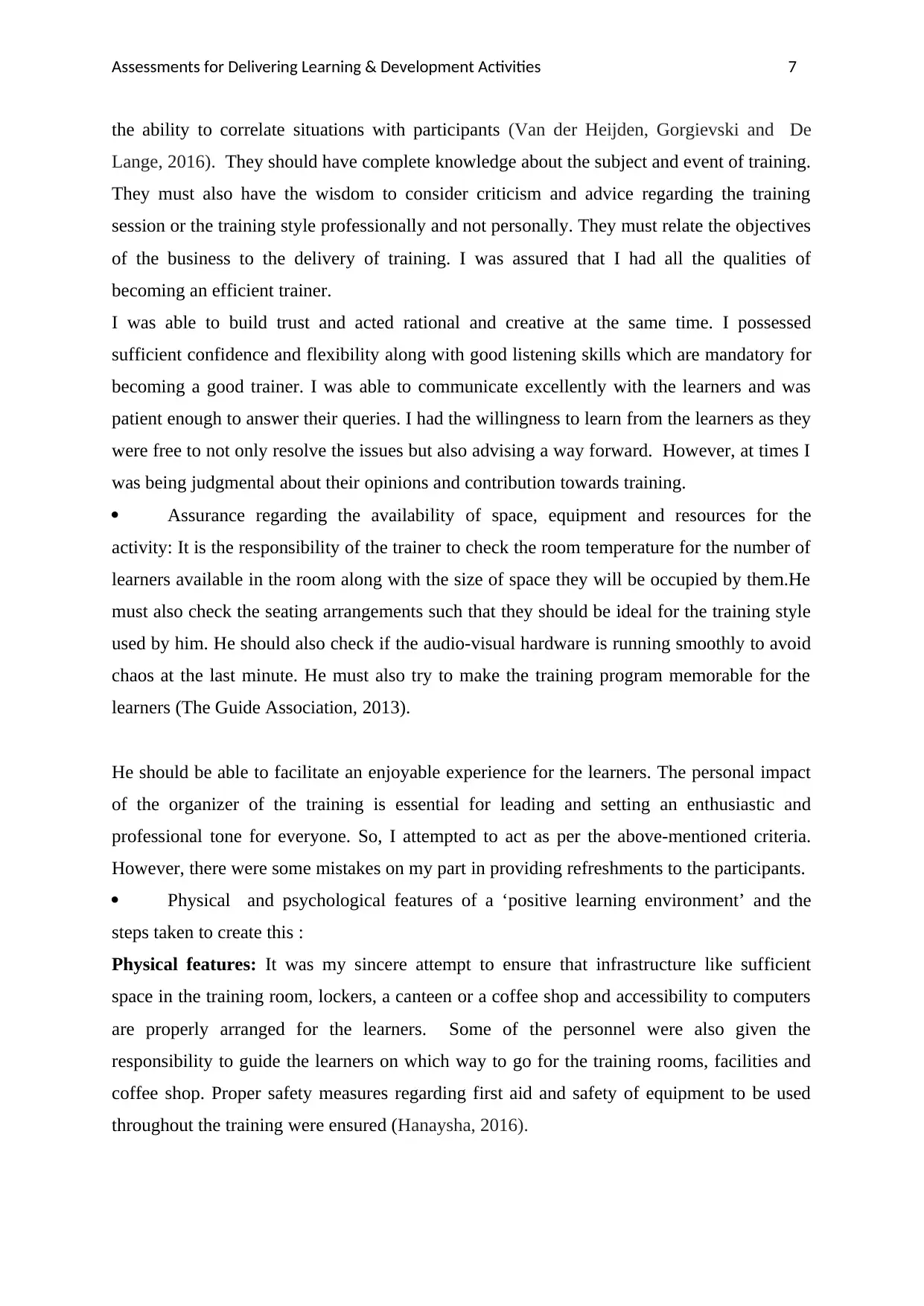
Assessments for Delivering Learning & Development Activities 7
the ability to correlate situations with participants (Van der Heijden, Gorgievski and De
Lange, 2016). They should have complete knowledge about the subject and event of training.
They must also have the wisdom to consider criticism and advice regarding the training
session or the training style professionally and not personally. They must relate the objectives
of the business to the delivery of training. I was assured that I had all the qualities of
becoming an efficient trainer.
I was able to build trust and acted rational and creative at the same time. I possessed
sufficient confidence and flexibility along with good listening skills which are mandatory for
becoming a good trainer. I was able to communicate excellently with the learners and was
patient enough to answer their queries. I had the willingness to learn from the learners as they
were free to not only resolve the issues but also advising a way forward. However, at times I
was being judgmental about their opinions and contribution towards training.
Assurance regarding the availability of space, equipment and resources for the
activity: It is the responsibility of the trainer to check the room temperature for the number of
learners available in the room along with the size of space they will be occupied by them.He
must also check the seating arrangements such that they should be ideal for the training style
used by him. He should also check if the audio-visual hardware is running smoothly to avoid
chaos at the last minute. He must also try to make the training program memorable for the
learners (The Guide Association, 2013).
He should be able to facilitate an enjoyable experience for the learners. The personal impact
of the organizer of the training is essential for leading and setting an enthusiastic and
professional tone for everyone. So, I attempted to act as per the above-mentioned criteria.
However, there were some mistakes on my part in providing refreshments to the participants.
Physical and psychological features of a ‘positive learning environment’ and the
steps taken to create this :
Physical features: It was my sincere attempt to ensure that infrastructure like sufficient
space in the training room, lockers, a canteen or a coffee shop and accessibility to computers
are properly arranged for the learners. Some of the personnel were also given the
responsibility to guide the learners on which way to go for the training rooms, facilities and
coffee shop. Proper safety measures regarding first aid and safety of equipment to be used
throughout the training were ensured (Hanaysha, 2016).
the ability to correlate situations with participants (Van der Heijden, Gorgievski and De
Lange, 2016). They should have complete knowledge about the subject and event of training.
They must also have the wisdom to consider criticism and advice regarding the training
session or the training style professionally and not personally. They must relate the objectives
of the business to the delivery of training. I was assured that I had all the qualities of
becoming an efficient trainer.
I was able to build trust and acted rational and creative at the same time. I possessed
sufficient confidence and flexibility along with good listening skills which are mandatory for
becoming a good trainer. I was able to communicate excellently with the learners and was
patient enough to answer their queries. I had the willingness to learn from the learners as they
were free to not only resolve the issues but also advising a way forward. However, at times I
was being judgmental about their opinions and contribution towards training.
Assurance regarding the availability of space, equipment and resources for the
activity: It is the responsibility of the trainer to check the room temperature for the number of
learners available in the room along with the size of space they will be occupied by them.He
must also check the seating arrangements such that they should be ideal for the training style
used by him. He should also check if the audio-visual hardware is running smoothly to avoid
chaos at the last minute. He must also try to make the training program memorable for the
learners (The Guide Association, 2013).
He should be able to facilitate an enjoyable experience for the learners. The personal impact
of the organizer of the training is essential for leading and setting an enthusiastic and
professional tone for everyone. So, I attempted to act as per the above-mentioned criteria.
However, there were some mistakes on my part in providing refreshments to the participants.
Physical and psychological features of a ‘positive learning environment’ and the
steps taken to create this :
Physical features: It was my sincere attempt to ensure that infrastructure like sufficient
space in the training room, lockers, a canteen or a coffee shop and accessibility to computers
are properly arranged for the learners. Some of the personnel were also given the
responsibility to guide the learners on which way to go for the training rooms, facilities and
coffee shop. Proper safety measures regarding first aid and safety of equipment to be used
throughout the training were ensured (Hanaysha, 2016).
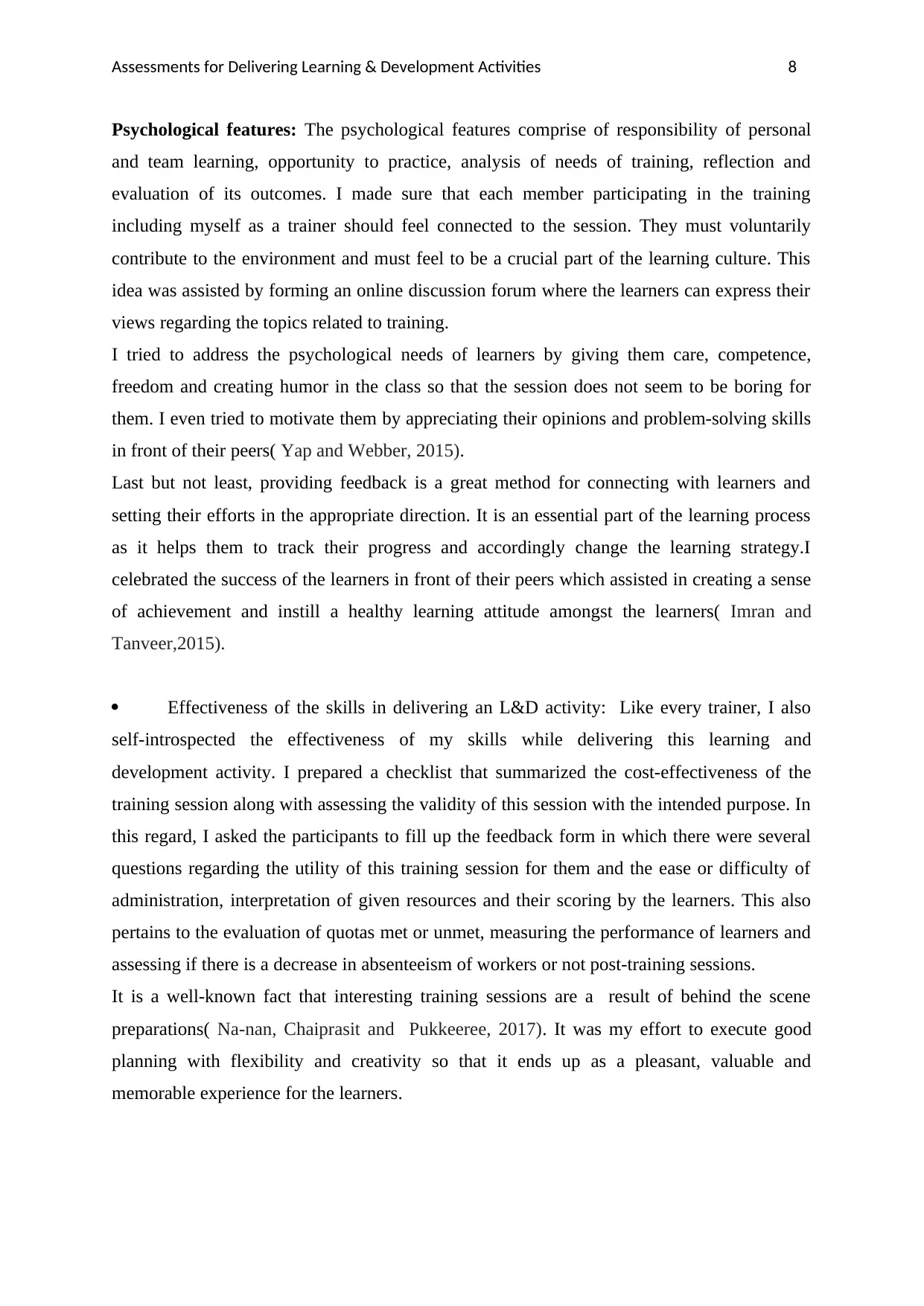
Assessments for Delivering Learning & Development Activities 8
Psychological features: The psychological features comprise of responsibility of personal
and team learning, opportunity to practice, analysis of needs of training, reflection and
evaluation of its outcomes. I made sure that each member participating in the training
including myself as a trainer should feel connected to the session. They must voluntarily
contribute to the environment and must feel to be a crucial part of the learning culture. This
idea was assisted by forming an online discussion forum where the learners can express their
views regarding the topics related to training.
I tried to address the psychological needs of learners by giving them care, competence,
freedom and creating humor in the class so that the session does not seem to be boring for
them. I even tried to motivate them by appreciating their opinions and problem-solving skills
in front of their peers( Yap and Webber, 2015).
Last but not least, providing feedback is a great method for connecting with learners and
setting their efforts in the appropriate direction. It is an essential part of the learning process
as it helps them to track their progress and accordingly change the learning strategy.I
celebrated the success of the learners in front of their peers which assisted in creating a sense
of achievement and instill a healthy learning attitude amongst the learners( Imran and
Tanveer,2015).
Effectiveness of the skills in delivering an L&D activity: Like every trainer, I also
self-introspected the effectiveness of my skills while delivering this learning and
development activity. I prepared a checklist that summarized the cost-effectiveness of the
training session along with assessing the validity of this session with the intended purpose. In
this regard, I asked the participants to fill up the feedback form in which there were several
questions regarding the utility of this training session for them and the ease or difficulty of
administration, interpretation of given resources and their scoring by the learners. This also
pertains to the evaluation of quotas met or unmet, measuring the performance of learners and
assessing if there is a decrease in absenteeism of workers or not post-training sessions.
It is a well-known fact that interesting training sessions are a result of behind the scene
preparations( Na-nan, Chaiprasit and Pukkeeree, 2017). It was my effort to execute good
planning with flexibility and creativity so that it ends up as a pleasant, valuable and
memorable experience for the learners.
Psychological features: The psychological features comprise of responsibility of personal
and team learning, opportunity to practice, analysis of needs of training, reflection and
evaluation of its outcomes. I made sure that each member participating in the training
including myself as a trainer should feel connected to the session. They must voluntarily
contribute to the environment and must feel to be a crucial part of the learning culture. This
idea was assisted by forming an online discussion forum where the learners can express their
views regarding the topics related to training.
I tried to address the psychological needs of learners by giving them care, competence,
freedom and creating humor in the class so that the session does not seem to be boring for
them. I even tried to motivate them by appreciating their opinions and problem-solving skills
in front of their peers( Yap and Webber, 2015).
Last but not least, providing feedback is a great method for connecting with learners and
setting their efforts in the appropriate direction. It is an essential part of the learning process
as it helps them to track their progress and accordingly change the learning strategy.I
celebrated the success of the learners in front of their peers which assisted in creating a sense
of achievement and instill a healthy learning attitude amongst the learners( Imran and
Tanveer,2015).
Effectiveness of the skills in delivering an L&D activity: Like every trainer, I also
self-introspected the effectiveness of my skills while delivering this learning and
development activity. I prepared a checklist that summarized the cost-effectiveness of the
training session along with assessing the validity of this session with the intended purpose. In
this regard, I asked the participants to fill up the feedback form in which there were several
questions regarding the utility of this training session for them and the ease or difficulty of
administration, interpretation of given resources and their scoring by the learners. This also
pertains to the evaluation of quotas met or unmet, measuring the performance of learners and
assessing if there is a decrease in absenteeism of workers or not post-training sessions.
It is a well-known fact that interesting training sessions are a result of behind the scene
preparations( Na-nan, Chaiprasit and Pukkeeree, 2017). It was my effort to execute good
planning with flexibility and creativity so that it ends up as a pleasant, valuable and
memorable experience for the learners.
⊘ This is a preview!⊘
Do you want full access?
Subscribe today to unlock all pages.

Trusted by 1+ million students worldwide
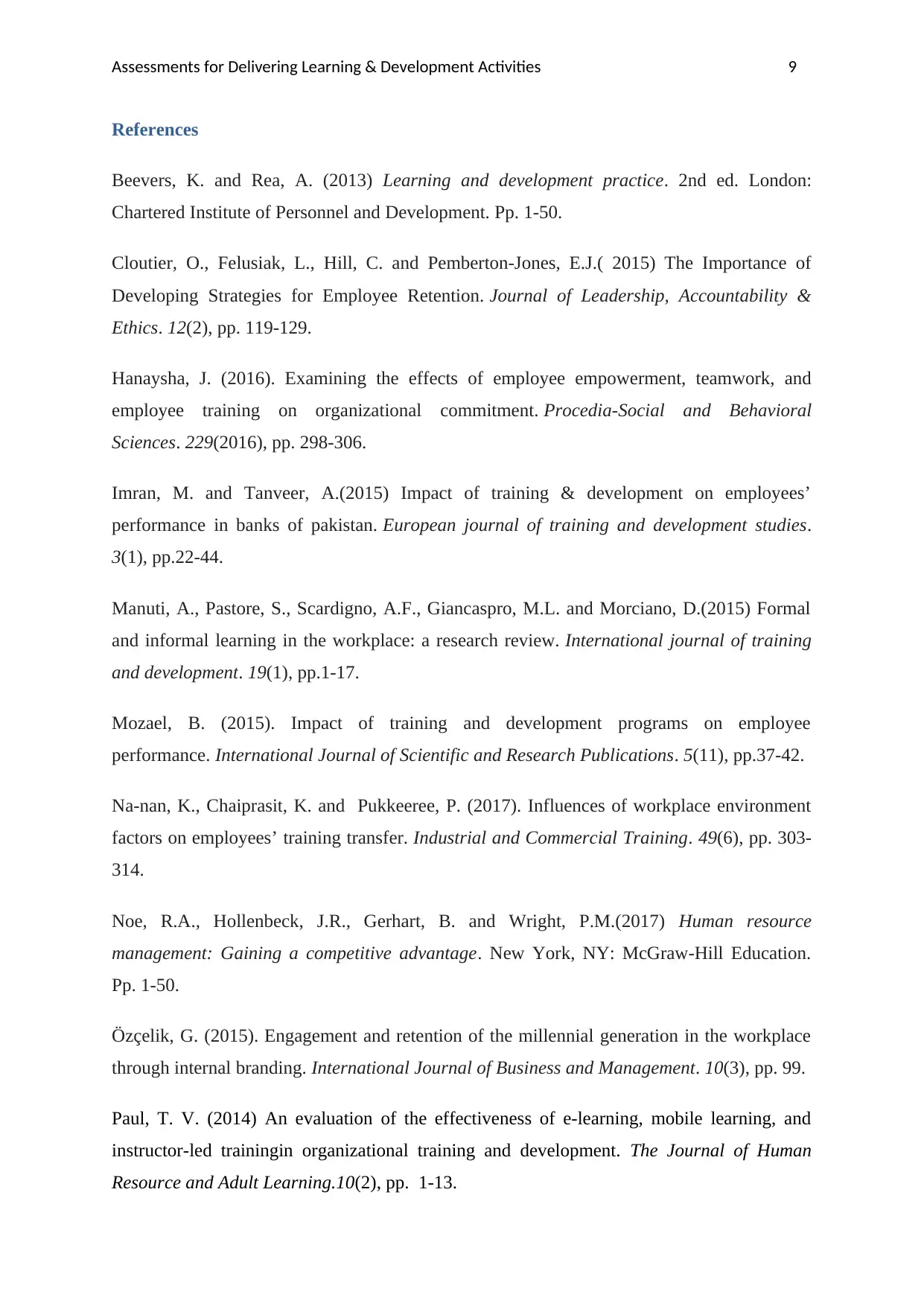
Assessments for Delivering Learning & Development Activities 9
References
Beevers, K. and Rea, A. (2013) Learning and development practice. 2nd ed. London:
Chartered Institute of Personnel and Development. Pp. 1-50.
Cloutier, O., Felusiak, L., Hill, C. and Pemberton-Jones, E.J.( 2015) The Importance of
Developing Strategies for Employee Retention. Journal of Leadership, Accountability &
Ethics. 12(2), pp. 119-129.
Hanaysha, J. (2016). Examining the effects of employee empowerment, teamwork, and
employee training on organizational commitment. Procedia-Social and Behavioral
Sciences. 229(2016), pp. 298-306.
Imran, M. and Tanveer, A.(2015) Impact of training & development on employees’
performance in banks of pakistan. European journal of training and development studies.
3(1), pp.22-44.
Manuti, A., Pastore, S., Scardigno, A.F., Giancaspro, M.L. and Morciano, D.(2015) Formal
and informal learning in the workplace: a research review. International journal of training
and development. 19(1), pp.1-17.
Mozael, B. (2015). Impact of training and development programs on employee
performance. International Journal of Scientific and Research Publications. 5(11), pp.37-42.
Na-nan, K., Chaiprasit, K. and Pukkeeree, P. (2017). Influences of workplace environment
factors on employees’ training transfer. Industrial and Commercial Training. 49(6), pp. 303-
314.
Noe, R.A., Hollenbeck, J.R., Gerhart, B. and Wright, P.M.(2017) Human resource
management: Gaining a competitive advantage. New York, NY: McGraw-Hill Education.
Pp. 1-50.
Özçelik, G. (2015). Engagement and retention of the millennial generation in the workplace
through internal branding. International Journal of Business and Management. 10(3), pp. 99.
Paul, T. V. (2014) An evaluation of the effectiveness of e-learning, mobile learning, and
instructor-led trainingin organizational training and development. The Journal of Human
Resource and Adult Learning.10(2), pp. 1-13.
References
Beevers, K. and Rea, A. (2013) Learning and development practice. 2nd ed. London:
Chartered Institute of Personnel and Development. Pp. 1-50.
Cloutier, O., Felusiak, L., Hill, C. and Pemberton-Jones, E.J.( 2015) The Importance of
Developing Strategies for Employee Retention. Journal of Leadership, Accountability &
Ethics. 12(2), pp. 119-129.
Hanaysha, J. (2016). Examining the effects of employee empowerment, teamwork, and
employee training on organizational commitment. Procedia-Social and Behavioral
Sciences. 229(2016), pp. 298-306.
Imran, M. and Tanveer, A.(2015) Impact of training & development on employees’
performance in banks of pakistan. European journal of training and development studies.
3(1), pp.22-44.
Manuti, A., Pastore, S., Scardigno, A.F., Giancaspro, M.L. and Morciano, D.(2015) Formal
and informal learning in the workplace: a research review. International journal of training
and development. 19(1), pp.1-17.
Mozael, B. (2015). Impact of training and development programs on employee
performance. International Journal of Scientific and Research Publications. 5(11), pp.37-42.
Na-nan, K., Chaiprasit, K. and Pukkeeree, P. (2017). Influences of workplace environment
factors on employees’ training transfer. Industrial and Commercial Training. 49(6), pp. 303-
314.
Noe, R.A., Hollenbeck, J.R., Gerhart, B. and Wright, P.M.(2017) Human resource
management: Gaining a competitive advantage. New York, NY: McGraw-Hill Education.
Pp. 1-50.
Özçelik, G. (2015). Engagement and retention of the millennial generation in the workplace
through internal branding. International Journal of Business and Management. 10(3), pp. 99.
Paul, T. V. (2014) An evaluation of the effectiveness of e-learning, mobile learning, and
instructor-led trainingin organizational training and development. The Journal of Human
Resource and Adult Learning.10(2), pp. 1-13.
Paraphrase This Document
Need a fresh take? Get an instant paraphrase of this document with our AI Paraphraser
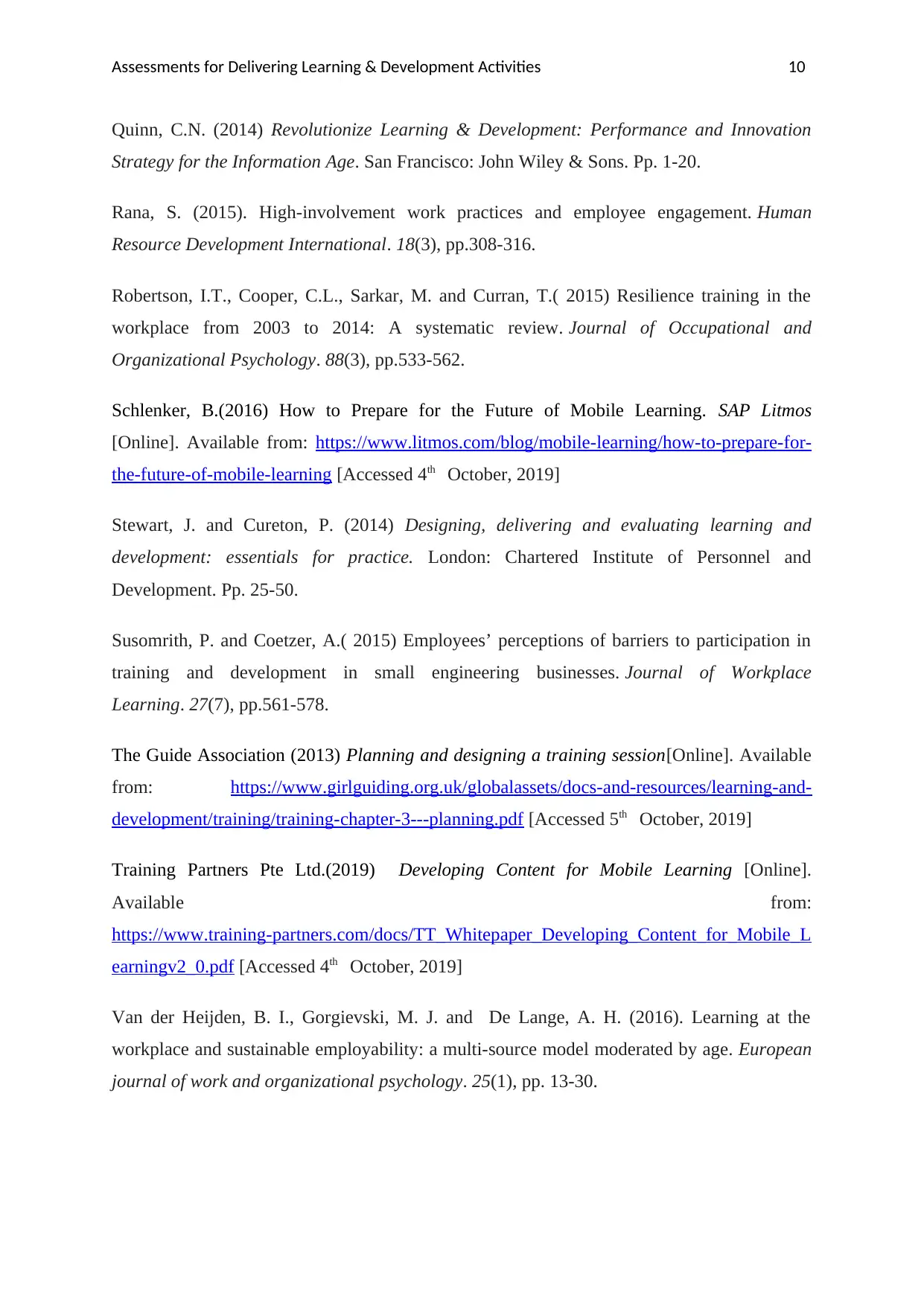
Assessments for Delivering Learning & Development Activities 10
Quinn, C.N. (2014) Revolutionize Learning & Development: Performance and Innovation
Strategy for the Information Age. San Francisco: John Wiley & Sons. Pp. 1-20.
Rana, S. (2015). High-involvement work practices and employee engagement. Human
Resource Development International. 18(3), pp.308-316.
Robertson, I.T., Cooper, C.L., Sarkar, M. and Curran, T.( 2015) Resilience training in the
workplace from 2003 to 2014: A systematic review. Journal of Occupational and
Organizational Psychology. 88(3), pp.533-562.
Schlenker, B.(2016) How to Prepare for the Future of Mobile Learning. SAP Litmos
[Online]. Available from: https://www.litmos.com/blog/mobile-learning/how-to-prepare-for-
the-future-of-mobile-learning [Accessed 4th October, 2019]
Stewart, J. and Cureton, P. (2014) Designing, delivering and evaluating learning and
development: essentials for practice. London: Chartered Institute of Personnel and
Development. Pp. 25-50.
Susomrith, P. and Coetzer, A.( 2015) Employees’ perceptions of barriers to participation in
training and development in small engineering businesses. Journal of Workplace
Learning. 27(7), pp.561-578.
The Guide Association (2013) Planning and designing a training session[Online]. Available
from: https://www.girlguiding.org.uk/globalassets/docs-and-resources/learning-and-
development/training/training-chapter-3---planning.pdf [Accessed 5th October, 2019]
Training Partners Pte Ltd.(2019) Developing Content for Mobile Learning [Online].
Available from:
https://www.training-partners.com/docs/TT_Whitepaper_Developing_Content_for_Mobile_L
earningv2_0.pdf [Accessed 4th October, 2019]
Van der Heijden, B. I., Gorgievski, M. J. and De Lange, A. H. (2016). Learning at the
workplace and sustainable employability: a multi-source model moderated by age. European
journal of work and organizational psychology. 25(1), pp. 13-30.
Quinn, C.N. (2014) Revolutionize Learning & Development: Performance and Innovation
Strategy for the Information Age. San Francisco: John Wiley & Sons. Pp. 1-20.
Rana, S. (2015). High-involvement work practices and employee engagement. Human
Resource Development International. 18(3), pp.308-316.
Robertson, I.T., Cooper, C.L., Sarkar, M. and Curran, T.( 2015) Resilience training in the
workplace from 2003 to 2014: A systematic review. Journal of Occupational and
Organizational Psychology. 88(3), pp.533-562.
Schlenker, B.(2016) How to Prepare for the Future of Mobile Learning. SAP Litmos
[Online]. Available from: https://www.litmos.com/blog/mobile-learning/how-to-prepare-for-
the-future-of-mobile-learning [Accessed 4th October, 2019]
Stewart, J. and Cureton, P. (2014) Designing, delivering and evaluating learning and
development: essentials for practice. London: Chartered Institute of Personnel and
Development. Pp. 25-50.
Susomrith, P. and Coetzer, A.( 2015) Employees’ perceptions of barriers to participation in
training and development in small engineering businesses. Journal of Workplace
Learning. 27(7), pp.561-578.
The Guide Association (2013) Planning and designing a training session[Online]. Available
from: https://www.girlguiding.org.uk/globalassets/docs-and-resources/learning-and-
development/training/training-chapter-3---planning.pdf [Accessed 5th October, 2019]
Training Partners Pte Ltd.(2019) Developing Content for Mobile Learning [Online].
Available from:
https://www.training-partners.com/docs/TT_Whitepaper_Developing_Content_for_Mobile_L
earningv2_0.pdf [Accessed 4th October, 2019]
Van der Heijden, B. I., Gorgievski, M. J. and De Lange, A. H. (2016). Learning at the
workplace and sustainable employability: a multi-source model moderated by age. European
journal of work and organizational psychology. 25(1), pp. 13-30.

Assessments for Delivering Learning & Development Activities 11
Yap, Q.S. and Webber, J.K.( 2015) Developing corporate culture in a training department: A
qualitative case study of internal and outsourced staff. Review of Business & Finance Studies.
6(1), pp.43-56.
Yap, Q.S. and Webber, J.K.( 2015) Developing corporate culture in a training department: A
qualitative case study of internal and outsourced staff. Review of Business & Finance Studies.
6(1), pp.43-56.
⊘ This is a preview!⊘
Do you want full access?
Subscribe today to unlock all pages.

Trusted by 1+ million students worldwide
1 out of 12
Related Documents
Your All-in-One AI-Powered Toolkit for Academic Success.
+13062052269
info@desklib.com
Available 24*7 on WhatsApp / Email
![[object Object]](/_next/static/media/star-bottom.7253800d.svg)
Unlock your academic potential
Copyright © 2020–2025 A2Z Services. All Rights Reserved. Developed and managed by ZUCOL.




